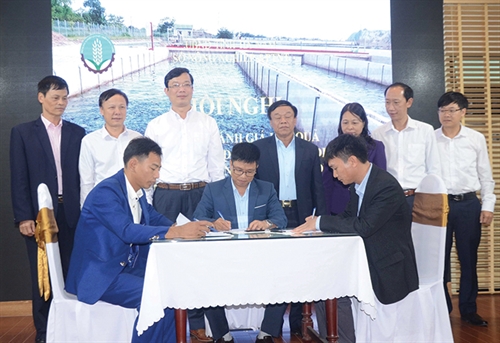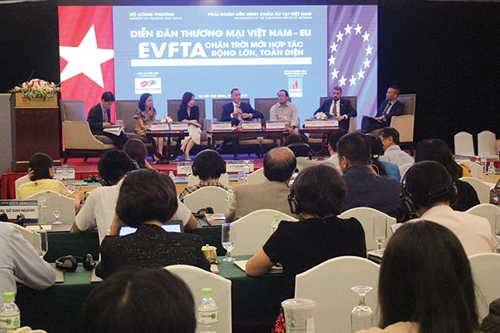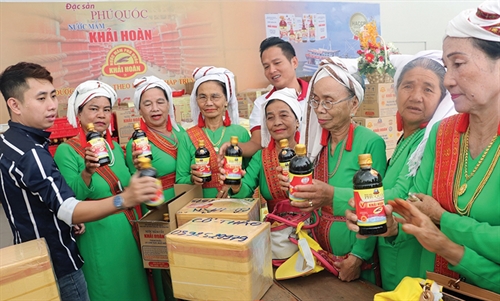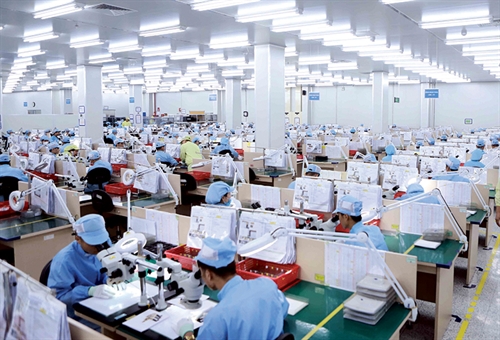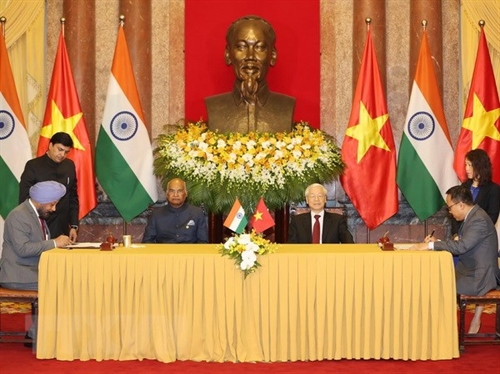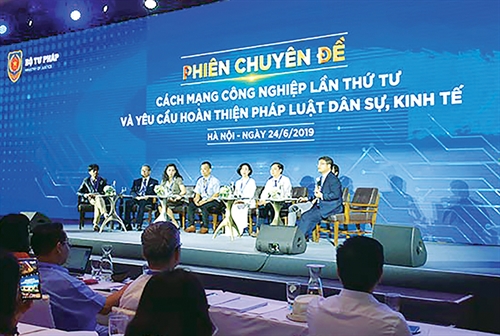Nguyen Thanh Nam[1] and Bui Duc Giang[2]
Law 44/2019/QH14 on Prevention and Control of Harms of Liquor and Beer Abuse (the Law) was passed on June 14, 2019, and became effective on January 1, 2020. On February 24, 2020, the Government issued Decree 24/2020/ND-CP (Decree 24) detailing a number of articles of the Law with effect from the same day. There are detailed rules in those texts on alcohol advertising that this Practice Note tries to examine.
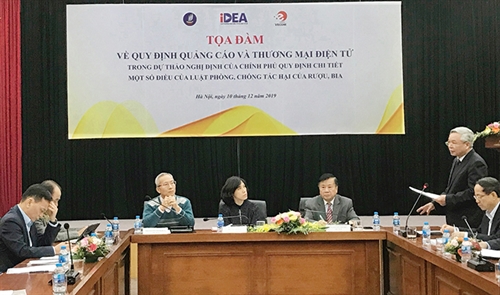 |
A seminar discussing advertising and e-commerce regulations of the draft law detailing the Law on Prevention and Control of Harms of Liquor and Beer in Hanoi on December 10, 2019__Photo: VNA |
| A seminar discussing advertising and e-commerce regulations of the draft law detailing the Law on Prevention and Control of Harms of Liquor and Beer in Hanoi on December 10, 2019__Photo: VNA |
Alcohol advertising
Legal framework
In Vietnam, the main rules governing advertising are set out in Law 16/2012/QH13 on advertising dated June 21, 2012, as amended in 2018 (Law on Advertising). Product placement (i.e., the inclusion in a program of, or a reference to, a product, service or trademark where the inclusion is for a commercial purpose, and is in return for the making of any payment to any relevant provider or any person connected with a relevant provider) is permitted in Vietnam broadcasting subject to specific limitations.
Article 7.3 of the Law on Advertising only prohibits advertising of spirits containing 15 percent alcohol or more. This prohibition is reiterated in Article 5.7 of the Law. In other words, advertising of spirits and wines containing less than 15 percent alcohol and beer is permitted. As a sector-specific legislation, the Law contains various restrictions as to advertising of spirits containing less than 15 percent alcohol and beer.
Specific restrictions
Article 13.1 of the Law includes a general prohibition on advertising of spirits containing between 5.5 percent alcohol and less than 15 percent alcohol and beer containing 5.5 percent alcohol or above in cultural, theatrical, cinematographic and sports programs.
The Law does not give the definition of a “sports program”. However, there are certain grounds backing the construction that a sports program would include a sports program broadcast on television or radio, specifically:
• Firstly, Article 12.3(c) of the Law addresses “sports programs the rights over which have been purchased” as broadcast sports programs.
• Secondly, when discussing the draft of the Law before its enactment at the National Assembly, the National Assembly deputies considered advertising in a sports program as advertising in a broadcast sports program[3].
Moreover, the Law should be applied not only to the letter but also in spirit (i.e., the intention of the provision concerned).
Therefore, it appears that the Law prohibits product placement for spirits containing between 5.5 percent alcohol and less than 15 percent alcohol and beer containing 5.5 percent alcohol or above in television or radio sports programs.
Furthermore, Article 12.3(c) prescribes that advertising of drinks containing less than 5.5 percent alcohol is prohibited on radio and television immediately before, during and after programs for children, or between 6 p.m. to 9 p.m. every day, with the exception of advertisements pre-installed in sports programs the rights over which have been purchased and which are transmitted live from overseas and other cases provided by the Government. Article 5.1 of Decree 24 provides a further exception for advertising of alcoholic drinks containing less than 5.5 percent alcohol appearing between 6 p.m. and 9 p.m. being advertising of alcoholic drinks of sponsors at the venue of regional, continental or world sporting games or competitions held in Vietnam being broadcast live on radio and television.
In addition, advertisements displayed on means of transport are prohibited (Articles 12.3(b) and 13 of the Law).
Article 13.2 of the Law also prohibits advertising of spirits containing between 5.5 percent alcohol and less than 15 percent alcohol and beer containing 5.5 percent alcohol or above via outdoor means of advertising, except signboards of alcoholic beverage businesses.
Advertising channels and means
Articles 12 and 13 of the Law and Article 5 of Decree 24 mention various advertising channels and means including broadcast advertising (i.e., advertising on television and radio), non-broadcast advertising (online press, social media (e.g., Facebook and YouTube), websites, electronic means, terminals and other telecommunications devices), as well as outdoor advertising (including bus advertising). As such, the prohibitions and restrictions contained therein apply to all those advertising channels and means.
Pursuant to Article 2.1 of the Law on Advertising, “advertising means the use of means to introduce to the public products, goods and services for a profit-making purpose; products and services without a profit-making purpose; and entities and individuals conducting business of introduced products, goods or services, except news on current affairs, social policies, or personal information”. Article 2.3 of this Law further indicates that “advertising product includes content and form of an advertisement expressed by imagery, sounds, spoken language, written language, symbols, colors, lights, and other similar forms”.
As such, the prohibitions and restrictions mentioned in this Practice Note will apply to all forms of advertisement such as TV commercials, sponsor panels, and pop-up advertisements and display of a sponsor’s logo within the credits or display of a sponsor’s name or logo in an object placed in a broadcast event or even any mention of a sponsor’s name in a sponsored program.
Sponsorship of programs
Article 14 of the Law provides: “entities and individuals acting as alcohol traders and providing sponsorship of programs shall comply with all laws and regulations relating to sponsorships and may not provide alcoholic beverages as part of their sponsorship”.
Of note, the Law on Advertising and more generally the advertising legislation do not specifically deal with program sponsorship. In practice, sponsorship of programs is regarded as a type of advertisement.
Therefore, it is not possible to run a competition with alcohol as a prize as part of a sponsored program broadcast on television or radio. For example, offering a “year’s supply” of alcohol, to be collected in weekly instalments will be considered as problematic and in breach of the prohibition mentioned above.
Age group and channel targeting
Under Articles 12.2 and 13 of the Law, alcohol advertisements must not:
• contain information or imagery aimed at encouraging alcoholic drinking;
• imply that alcoholic beverages may enable maturity, success, friendliness or sexual allure;
• be targeted at children, pupils, students, adolescents or pregnant women;
• use objects, imagery, symbols, music, movie characters or brands of products intended for children, pupils or students, or,
• employ people under 18 years of age or their images.
Therefore, alcohol advertisers must ensure that advertisings do not encourage alcohol drinking. This would relate to both the quantity of alcohol consumed and the manner in which the consumption is portrayed, including claims or imagery which directly encourage consumption of alcohol. For instance, it would be likely to be problematic to use a slogan like ‘sometimes one drink is never enough’.
Care should also be taken not to link alcohol to maturity, success, friendliness or sexual allure. Alcohol advertisers must also take care not to use objects, imagery, symbols, music, characters (real or fictitious), or product brands that are likely to appeal particularly to people under 18 years of age or students.
In particular, such advertising must be targeted properly to the right age groups. Under Articles 12.3(a) and 13 of the Law, advertisements must not appear in any events, through any advertising means or products that are intended for people under 18 years of age, pupils, students, adolescents or pregnant women. Advertisers must be mindful about the selection of media and context in which advertisements will appear. Alcohol advertisements should not appear in a medium if the targeted audience is under 18 years of age. Advertisers are expected to hold evidence that this is not the case. For a TVchannel, the program channel production license granted by the Ministry of Information and Communications may indicate whether it is dedicated for children or not. Particular care should be taken when using social media.
Specific requirements
The new rules provide certain requirements as to content of advertisements, manner of displaying them as well as some specific technical requirements.
Articles 12.4 and 13 of the Law on Preventive and Curative Measures against Adverse Effects of Alcohol require that any alcohol advertisements contain regulated warnings to prevent and fight negative effects of alcohol. Pursuant to Article 5.3 of Decree 24:
• Alcohol advertisements must include one of the following warnings (warning): “drinking alcohol may cause road accidents”, “drinking alcohol can affect foetal health” and “people under 18 years of age are not allowed to drink alcohol”[4];
• Alcohol advertising on radio, television and advertisements recorded in an audio or visual material shall read out the warning at the same speed of reading as other contents in the same advertisement;
• Alcohol advertising on television, e-newspapers, websites, social media, radio with imagery, electronic means of communication (e.g., LED screen), terminal equipment and other telecommunications equipment with imagery, or visual alcohol advertisements must contain the warning with letters of a color constrating with the background color to ensure a clear view, which must occupy a minimum of 10 percent of the advertisement space. For alcohol advertising on television, the warning must be displayed in full width of the screen;
• Advertisements at points of sale of alcohol must have the warning written in clear and noticeable words, or audio and audio-visual recordings of advertisements satisfying the above requirements.
• Alcohol advertising other than the above cases must have the warning written in clear and noticeable words.
Furthermore, Articles 12.5 and 13 of the Law require that advertisements on e-newspapers, websites, electronic means of communication, terminal equipment and other telecommunications equipment must have a content filtering technology and software to control the age of visitors with a view to preventing people under 18 years of age from accessing and searching for information on alcohol.
Article 5.4 of Decree 24 indicates that such requirement applies also to advertisements displayed on social media platforms and sets forth the following detailed requirements:
• Not to display the advertisement before the visitor declares his/her age;
• Advertising may not be linked to and targeted at user’s accounts/profiles of those under 18 years of age, or Internet pages, channels or other information communication means available online and dedicated strictly to people under 18 years of age or with the majority of users under 18 years of age;
• If the alcohol advertising is displayed before the effective date of Decree 24 but fails to satisfy the above requirements, such display may be valid until the expiry date of the advertising contract which may not be extended. Basically, this means that upon the expiration of the advertising contract, the parties have to sign a new one to comply with the above requirements.
In addition, Article 5.2 of Decree 24 prescribes that advertising of drinks containing less than 5.5 percent alcohol on outdoor means must comply with the following rules:
• The size of the billboard shall comply with all national technical standards applied to the relevant advertising means;
• A minimum distance of 200 meters from the point at which an advertising facility is installed to the nearest boundary of premises of a nursery, primary or high school, a nursing care center, or a recreational or entertainment center intended for people under 18 years of age and a minimum distance of 100 meters from the point at which an advertising facility is installed to the nearest boundary of premises of a vocational or higher education institution are required except for signboards of alcohol businesses. If an advertisement has been placed on outdoor advertising facilities located within the aforementioned distances before the effective date of Decree 24, such advertising may be valid until the expiration of the advertising contract which may not be extended. In other words, upon expiration of an advertising contract, the parties must sign a new one to comply with the above requirements.
Alcohol promotion
Under Article 5.3 of the Law, promotion of alcoholic drinks to persons under 18 years of age is prohibited. All promotions in the commercialization of alcoholic drinks containing 15 percent alcohol or above are also prohibited (Article 5.9 of the Law).
As per the same article, the use of alcoholic drinks containing 15 percent alcohol or above in any forms whatsoever is prohibited. This applies not only to alcohol traders but also to all other types of traders wishing to use alcoholic drinks to promote their products, goods or services.
Article 11 of the Law provides that “any entities or individuals carrying out promotion [for or using] beverages containing less than 15 percent alcohol must comply with the provisions of this Law and the [general] legislation governing promotions”.
Article 5.2 of Decree 81/2018/ND-CP dated May 22, 2018, guiding in detail the Commercial Law with regard to trade promotion (Decree 81) prescribes that goods or services used for promoting goods and/or services must not include wines and spirits (Article 5.2). Furthermore, promotions do not apply to wines and spirits (Article 5.1 of Decree 81).
Reading this Article together with the above provisions, it can be inferred that:
• The use of wines, spirits and beer containing 15 percent alcohol or more to promote goods and services is prohibited;
• Promotions do not apply to beer containing 15 percent alcohol or more, wines and spirits;
• Only beer containing less than 15 percent alcohol may be used for promotions; and
• Promotion of beer to persons under 18 years of age is prohibited.
In light of the above, it can be inferred that the provisions of the Law and Decree 24 are quite detailed but the key themes revolve around ensuring that advertising of alcohol is carried out in a socially responsible way. This means that when advertisers are devising their creative, they need to make sure that their messages are in line with this general aim.- (VLLF)
